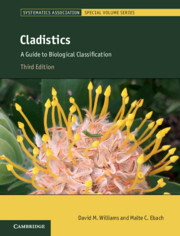Book contents
- Cladistics
- The Systematics Association Special Volume Series
- Cladistics
- Copyright page
- Dedication
- Contents
- Preface
- Acknowledgements
- Introduction: Carving Nature at Its Joints, or Why Birds Are Not Dinosaurs and Men Are Not Apes
- Part I The Interrelationships of Organisms
- Part II Systematics: Exposing Myths
- Part III The Cladistic Programme
- Part IV How to Study Classification
- Part V Beyond Classification
- 13 Beyond Classification: How to Study Phylogeny
- 14 The Separation of Classification and Phylogenetics
- 15 Further Myths and More Misunderstandings
- Afterword
- Index
- Systematics Association Special Volumes
- References
14 - The Separation of Classification and Phylogenetics
from Part V - Beyond Classification
Published online by Cambridge University Press: 20 July 2020
- Cladistics
- The Systematics Association Special Volume Series
- Cladistics
- Copyright page
- Dedication
- Contents
- Preface
- Acknowledgements
- Introduction: Carving Nature at Its Joints, or Why Birds Are Not Dinosaurs and Men Are Not Apes
- Part I The Interrelationships of Organisms
- Part II Systematics: Exposing Myths
- Part III The Cladistic Programme
- Part IV How to Study Classification
- Part V Beyond Classification
- 13 Beyond Classification: How to Study Phylogeny
- 14 The Separation of Classification and Phylogenetics
- 15 Further Myths and More Misunderstandings
- Afterword
- Index
- Systematics Association Special Volumes
- References
Summary
Ernst Haeckel (1834–1919) and Karl Gegenbaur (1826–1903) first combined systematics with phylogenetics in Systematische Phylogenie (1894–1896, see the earlier and better known Haeckel, 1866) and the second edition of Grundzüge der vergleichenden Anatomie (Gegenbaur, 1870), the latter more concerned with developing the new field of evolutionary morphology (for a review of Gegenbaur see Hoβfeld et al. 2003); Adolf Naef (1883–1949) separated them in his Systematic Morphology (Naef 1919; for a review see Rieppel et al. 2013); Willi Hennig (1913–1976) brought them back together again with his Phylogenetic Systematics (Hennig 1950, 1966, see Rieppel et al. 2013 and Williams et al. 2016); Nelson and Platnick separated them once again in their Systematics and Biogeography (Nelson & Platnick 1981); and so it goes. In any case, Naef’s statement that natural [systematics] classification is the major task of comparative biology and ‘its foundations were laid even before the time of Darwin’ (Naef 1972, p. 12, translated from Naef 1921, p. 61) remains accurate and appealing (Naef 1919, 1921–1923).
- Type
- Chapter
- Information
- CladisticsA Guide to Biological Classification, pp. 369 - 395Publisher: Cambridge University PressPrint publication year: 2020



